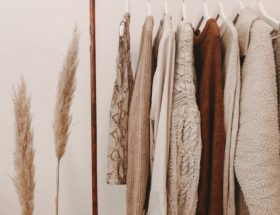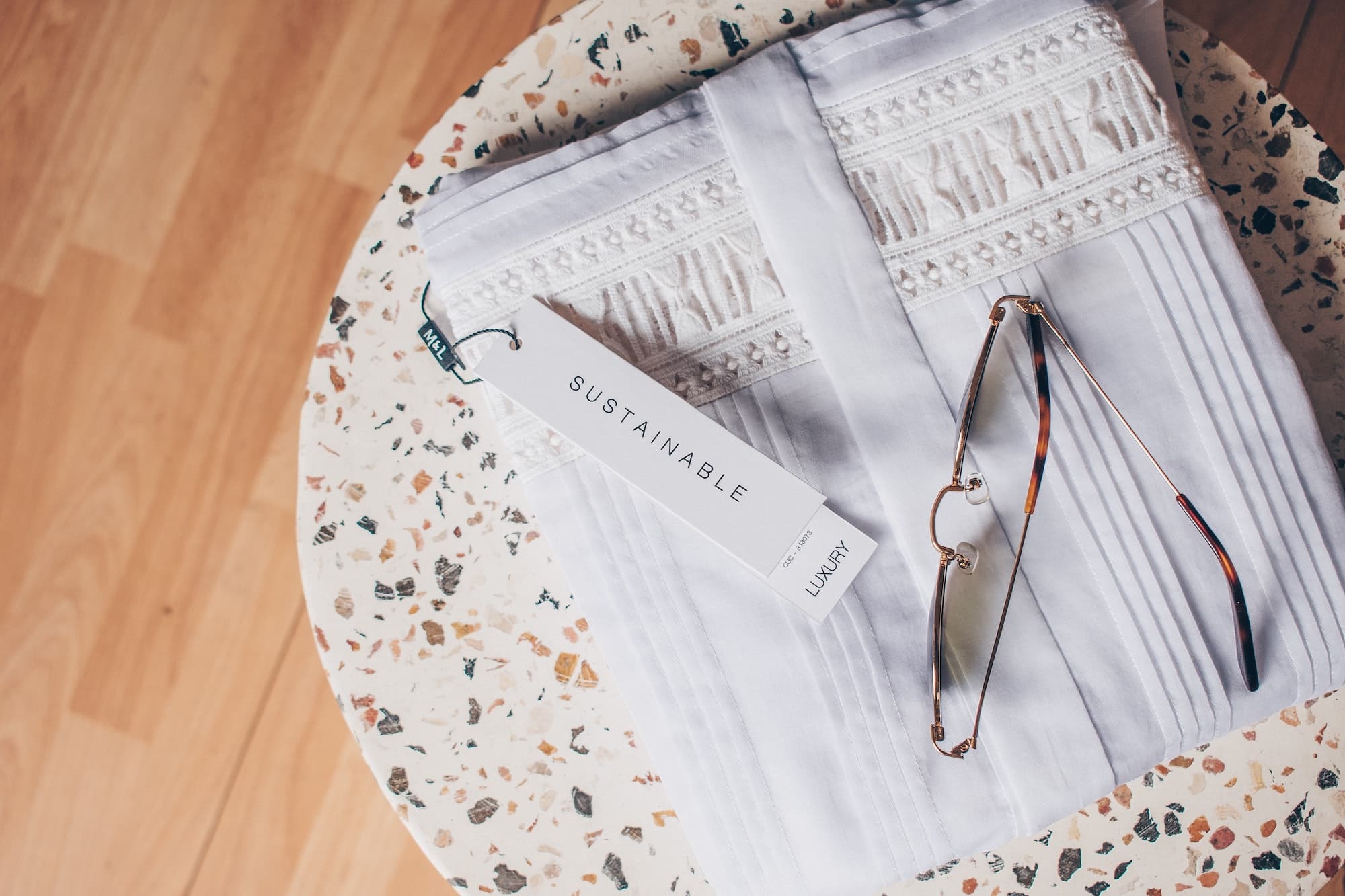By Pauline Weston Thomas for Fashion-Era.com

1999s Fashion History - Global Fashion Attitudes
- Influences on Millennium Fashion
- Choose Vintage Fashion Dressing
- Rejection of Logos for Hidden Confidence of Luxury Yarn
- Global Marketing and Shopping
- American Designers
- Capsule Dressing from Donna Karan
- Colours
- Pashminas
- Camouflage and Animal Patterns
- Stockings, Leggings, Pantyhose Tights and Nude Legs
- Shoes
- Dancing
- The Future
- Shopping Telly
Influences on Millennium Fashion
People watchers, spotters and trend predictors ensure that designers of today are likely to be influenced by street fashion. But all too frequently they pick up an idea which kills it flat at the street level source. They have an eye to global commercial profits from the trickle down effect on their ready to wear ranges.
This makes for a lack of creativity as clothes develop homogenized uniformity. Watered down versions that are picked up by chain stores all have the same look that fails to stimulate the ordinary shopper.
In a market saturated with retail outlets, clothing sales have been falling, flagging and failing. The consumer simply has too many shopping places to choose from, so spending power gets spread very thinly between all the outlets or directed to specific branded cult goods.
Choose Vintage Fashion Dressing
Little wonder film stars have started to wear vintage designer clothes from past generations.
No doubt individuals will soon start to seek out little dressmaker clothes as young girls did when they patronised Mary Quant in the 1960s. Certainly those with real money hardly want to be seen sporting the same designer top or handbag as their best friend and at a hugely inflated price.
The purpose of fashion is to reveal individual differences not provide identikit uniforms. Spotting or setting a trend early is crucial to the integrity of fashion makers.
Films are still important as influences on fashion and trends for fashion, make up, hairstyles and jewellery. A recent example of this is the influence of the Nicole Kidman film Moulin Rouge and the lace Edwardian clothing that has been copied for the high street.
Rejection of Logos for Hidden Confidence of LuxuryYarn
Some individuals have already started to reject logos and emblematic brand promotion in favour of understated confidence gained from the more subtle hidden knowledge that they alone know they are wearing a quality cashmere garment or expensive Italian silk lace bra. That no one else knows they are wearing luxury and having a private sensual experience reconfirms an individual's sense of identity and personal worth.
The individual who knows they have luxury goods on their body creates a certain self smugness which can be very satisfying. Exclusive fashion goods produced by small workshops or individuals and often only obtainable over the Internet are likely to develop a good market share in the next few years. Already individuals who want cachet have their own perfumes made by exclusive companies who are not marketing their fragrances in a global way. Rareness and exclusivity increases desirability.
The fashion cognoscenti will not miss the exclusive factor if it really does have any significance.
Global Marketing and Shopping
Ordinary people shop all over the world today. They take a bucket shop air ticket or limited stay ticket and jet to a major city like London, Paris, Hong Kong, Barcelona, Boston, Los Angeles, New York, Florence or Milan simply to shop until they drop. Every tourist office in the world will have day trips that make shopping its main purpose and cruise ships stop at ports for guests to stock up on even more local goodies than are already available onboard.
In England you are never more than twenty or thirty minutes from a town with shops or factory outlet shops a few miles further. In more remote parts of Britain you might have to travel up to an hour. And if you are immobile, shopping TV will probably solve your need for a shopping fix.
American Designers
In the late 20th century no other country marketed fashion like the Americans. The best known designers in America and known by all, are Donna Karan, Tommy Hilfiger, Calvin Klein and Ralph Lauren.
Calvin Klein uses advertising that highlights sexuality enough to shock a supposedly unshockable society. Erotic advertising is used to promote his diffusion lines from perfume and fashion to home furnishings. Ralph Lauren has been the arbiter of good taste in classic good looking clothes and a covetable stylish home range.
By contrast Hilfiger's clothes are aimed at the mass youth market with an easily recognisable predictable casual format of red, navy and white basics covered in logos for street wear.
In the USA all these designers along with sportswear giants Nike and Adidas have far more cachet with American consumers than Agnes B, Prada, Fendi or Gucci have in Europe.
Capsule Dressing From Donna Karan
Donna Karan designs for women on the go. She uses quality jersey with Lycra and great cutting to produce capsule wardrobe garments that hide real women's body defects. Her name was already a winner when she launched her DKNY range of affordable ready to wear items. Like Calvin Klein she uses subtle colour combinations of creamy honeys, champagnes and taupes as well as a never ending range of wearable black.
If you are in the UK you can buy Donna Karan's clothes at the Bicester Outlet Village (near Oxford) as well as from Bond Street London and from the Internet.
Karan's fashion label brand is huge and so desirable that in January 2001, LVMH bought Gabrielle Studio the license-holding company for Karan. In April 2001 LVMH also bought the company DKI making a total buy of $643 million. LVMH market the Donna Karan range as luxury lifestyle brands throughout the world.
Colours
Women of the nineties had learnt how to build capsule wardrobes from other ranges based on Karan's ideas. It's one reason why the nineties were so black. Lack of colour might be a better heading.
It was only in the last few years of the 90s that colour began to return and be worn by individuals. After some of the garish hues of the 1980s, black and more black was dominant for some ten years. Women discovered real easy dressing - black goes well with black and other neutrals. Some equally dull, but neutral browns and greys did become the so called new black for a brief season or so.
Consumers took to the drab colours with reluctance. Subtlety was everything as 80's gilt buttons were suddenly banished and dirtied dusty colours dominated the racks. The taupes, pastel pinks, olives, greys, browns, subdued rusts, greyed navy, sand and camel were a huge change from the glowing brilliant sea greens, fuchsia pinks, reds and royal blues of the 80s. Certainly in the UK the only full length coat colours to wear in the 1990s were black, camel, navy or grey.
Bright coats were never really seen and royal blue was banished once Thatcher lost power in UK. Individuals felt noticeably conspicuous in bright colours amid a sea of black. Blend in understatement became the way to dress. Only strong individuals had the courage to wear hues that suited their skin colouring rather then draining it.
Pashminas
Colours based on primary and secondary hues seemed to disappear from sight until the late 90s. Around 1997, feminine dresses in bright silks and colourful Pashmina shawls in many pastel tones became usual. Women began to wear stronger pinks, lilac, purples, reds, lime green and turquoise again. Fashion began to be pretty again and welcomed by those who wanted to relinquish track suits and sportswear or by many who had never adopted them.
The Pashmina shawl softened the drab coat colours, and also doubled as a warm stole wrap on summer evenings and at cold winter venues. Tied in the Fulham Knot as shown in the heading it became the main way to get rid of the bulk of the Pashmina when worn as a scarf.
By the year 2000 Pashminas were a mass fashion and many moved onto newer ideas. It did not go away however as many found it so useful. It returned with expensive embroidery or beadwork in 2001.
Camouflage and Animal Patterns
Camouflage patterns appeared frequently on all ranges of clothes. By 1998 the military look turned up again as combat pants and flak jackets and yet again in 2001 as a main look for summer.
In the distant past once it was realised that gaudy bright red uniforms acted as easy targets for the enemy, camouflage materials were used. They began simply as fabrics that blended such as khaki tints and shades which toned in neutrally with the landscape.
High street and chain store versions abounded. Gerry Weber printed semi sheer chiffon camouflage blouses. Dorothy Perkins and Marks & Spencer also used camouflage prints whilst Versace led with catwalk designs. Now over 350 camouflage patterns exist including the British disruptive pattern and the tiger stripe used in Vietnam.
A new, more effective but less aesthetic, neater digital Marine camouflage pattern (Marpat) was unveiled by the American Marines recently to upgrade the battle effectiveness of former 20 year old patterns.
Animal prints were equally popular ranging from leopard, wild cat, tiger, cow and zebra prints.
Stockings, Leggings, Pantyhose Tights and Nude Legs
In the late 80s and early 90s the stocking with lace top holding itself up was suddenly noticed to be more erotic than a pair of tights. Leggings were a common sight in the early 90s and continued to be worn well past their sell by date in the privacy of homes.
By the early 1990s the only tights to wear with the short skirt of the time was black and opaque. By the late 90s the bare nude look leg was in vogue and natural toned tights were acceptable again. Many younger women simply abandoned tights altogether preferring the totally natural leg. Never before frowned upon until the nineties, the biggest faux pas was to wear tights with open strappy sandals.
At the same time many variations of tights came into the shops. These could range from soft and sheer to shiny, support or bare effects. Wearing tights still remains correct for business wear and it's best to avoid bare legs for any occasion unless the legs are silky smooth and fuzz free.
Designer Label Shoes
In the 1990s status shoes such as those by Manolo Blahnik, Jimmy Choo and Italian brands by Prada, Gucci and Renata and others took on a new importance as fashion itself became cleaner and more minimal and pared down.
During the early 1990s many UK national chain footwear shops closed because of poor trading conditions in the market, but the market regained buoyancy by the end of the decade, and the mass made footwear now on offer is of superior quality to 30 years ago.
Alongside all the fashion changes styles like Birkenstock and Clarks England make huge sales because of the comfort factor in their everyday footwear.
Footwear Future
Since 2001 the shoe shops have suddenly seen the influence of designers like Jimmy Choo appear in everyday footwear ranges. Pretty shoes with an interesting array of heels of all sorts.
Newer cone heels and Louis hourglass heels are catching the attention of women again. Niche footwear outlets such as Nine West are gaining a market share and help offer a very diverse range of footwear for all tastes. Victorian boots head the millennium.
1990's Lambada and Salsa
Erotic dances such as the Salsa and exotic Bahia based rhythmic Lambada took off about 1991 and were very popular throughout Europe. Both were popular enough to encourage enthusiasts to take short courses in the dance. Pretty silk dresses with cowl necks or bandeau bra dresses with shoe string straps or Azzedine Alaďa bandage Lycra dresses were ideal to show off a swaying body.
Line Dancing
The dance craze of the 1990s was the craze for line dancing that spawned a whole new era of dance as a pleasurable form of unisex exercise with rows of dancers of every age following the instructions of the master of ceremonies. Western inspired line dancing created a demand for appropriate western cowboy influenced clothing. Some artistic license was used to create rather theatrical versions of what a rancher might have worn and the only general effect in main stream fashion were the interesting boot variations.
The Future
Mail order and home shopping is growing. Customers no longer have to wait up to 28 days to receive an order. Orders from TV shopping channels frequently arrive within 2 to 4 days or next day if you pay special delivery.
QVC a major TV shopping channel in UK, USA and parts of Europe already has over 5 million customers in UK alone. Ordering is simple and instant with a touch tone telephone and clothes for example arrive 5 - 7 working days later, with a 30 day money back guarantee if you don't like an item or it doesn't fit.
Shopping Telly
Home shopping is the future for a large percentage of fashion retailing. Trend experts predict that by 2010 more than 80% of shopping will be delivered to our homes. The fact is that many of us already browse all day in the shopping mall, but don't fret if we don't buy that day. We know from experience that the same or similar item is frequently available at less cost through direct shopping with home delivery such is the uniformity of mass produced goods in the third millennium.
However I believe that some of the so called 'TV fashion shopping hours' will for many people be replacement buying of everyday clothes rather than high fashion purchases.
Perhaps there will be nods to current fashion colours and trims, but many of the TV sales will be for comfortable easy wear garments. A few better items such as the washable suede jacket of a recent TV showing show efforts to combine easy care with the current fashion for skins.
Interestingly the viewing market is far more discriminating than the TV companies realise. Browse around the superb website at shoppingtelly.com and you will find a discriminating bunch of consumers who analyse not only the products, but how they are presented and delivered. You will also find advance warning of special offers and cryptic comments in the shopping telly forum on a vast range of consumer products.
There is already a temptation for the more mediocre TV shopping channels to reproduce some items deliberately aimed to be safe, in cheap fabrics to make a cheap price, but which are unfashionable, shapeless and large enough to suit those who can find nothing to fit in the shops. Such channels are responding to a real demand for super sized clothes, but one can hardly describe them as fashion items. Some channels that have fashion hours should really rename them 'clothing hours'.
One thing is certain - Shopping TV is here to stay for now as long as the companies get their marketing right and know their target audience whether it be up, or downmarket. You may well find yourself tempted to buy and once you have one successful purchase that more than satisfies your high standards and needs, you will take the risk again and again.


